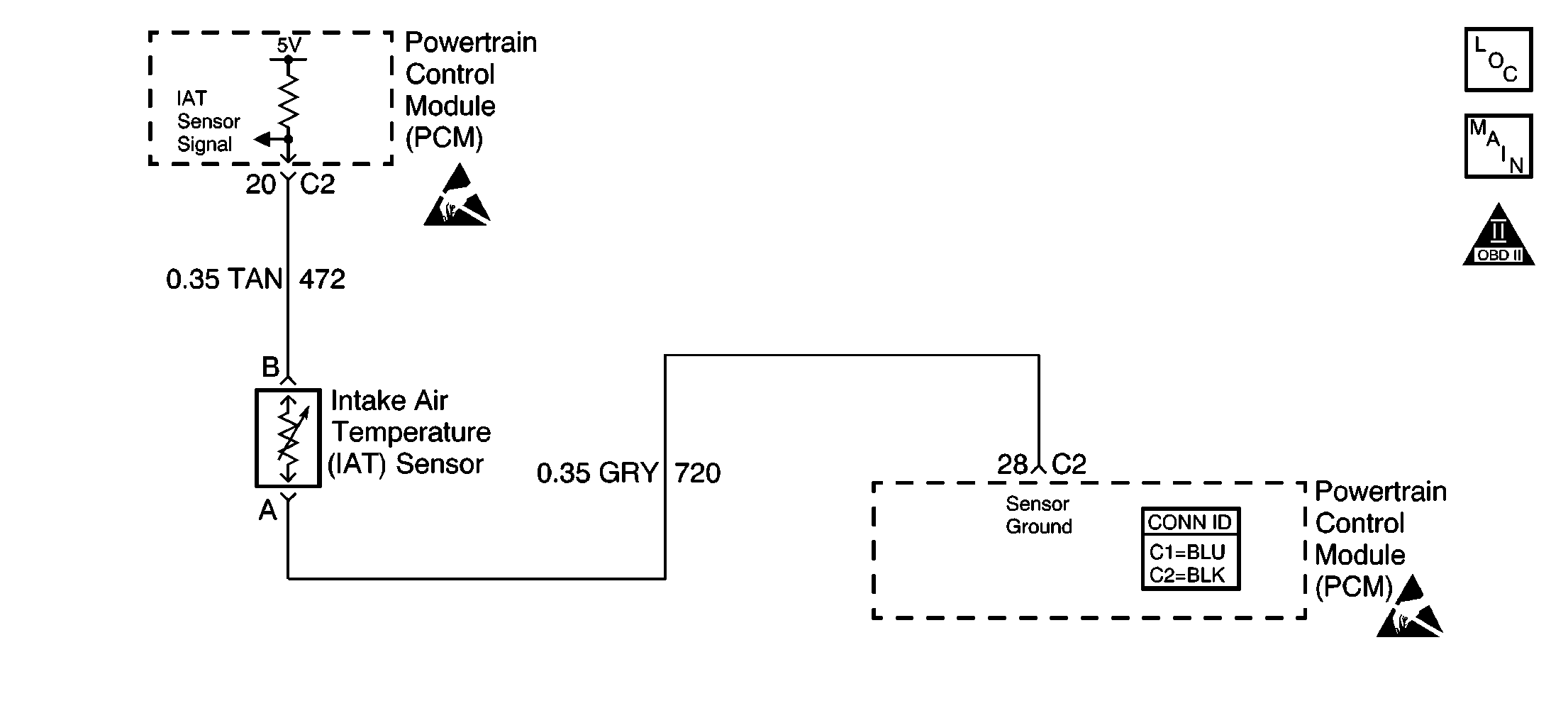
Circuit Description
The intake air temperature (IAT) sensor uses a thermistor to control the signal voltage to the Powertrain Control Module (PCM). The PCM supplies a 5 volt reference and a ground to the sensor. When the air is cold the resistance is high, therefore the IAT signal voltage will be high. If the intake air is warm, resistance is low, therefore the IAT signal voltage will be low.
Conditions for Running the DTC
| • | The engine run time is more than 320 seconds. |
| • | The vehicle speed sensor indicates that vehicle speed is more than 15 mph (24 km/h). |
Conditions for Setting the DTC
The IAT sensor signal voltage indicates that the intake air temperature is more than 128°C (262°F) for 3.125 seconds.
Action Taken When the DTC Sets
| • | The malfunction indicator lamp (MIL) will illuminate after two consecutive ignition cycles in which the diagnostic runs with fault active. |
| • | The PCM will record operating conditions at the time the diagnostic fails. This information will be stored in the Freeze Frame and Failure Records buffers. |
| • | A history DTC is stored. |
| • | The coolant fan turns ON. |
| • | The PCM will default to 60°C (140°F) for intake air temperature. The scan tool will not the show the defaulted value. |
Conditions for Clearing the MIL/DTC
| • | The MIL will turn OFF after three consecutive ignition cycles in which the diagnostic runs without a fault. |
| • | A history DTC will clear after 40 consecutive warm-up cycles without a fault. |
| • | Use a scan tool to clear the DTCs. |
Diagnostic Aids
| • | If the vehicle is at ambient temperature, compare the IAT sensor to the ECT sensor. The IAT sensor and the ECT sensor should be relatively close to each other. |
| • | Use the Temperature vs. Resistance Values table to evaluate the possibility of a skewed sensor. Refer to Temperature Versus Resistance . |
Test Description
The numbers below refer to the step numbers on the diagnostic table.
-
The Powertrain On-Board Diagnostic (OBD) System Check prompts you to complete some of the basic diagnostics and to store the Freeze Frame and Failure Records data on the scan too, if applicable. This creates an electronic copy of the data that was captured when the malfunction occurred. The scan tool stores this data for later reference.
-
This step simulates a DTC P0113 condition. If the scan tool displays the specified value, the IAT signal circuit and the PCM are OK.
-
Reprogram the replacement PCM and perform the crankshaft position system variation learn procedure. Refer to the latest Techline™ information for PCM programming.
Step | Action | Value(s) | Yes | No |
|---|---|---|---|---|
Did you perform the Powertrain On-Board Diagnostic (OBD) System Check? | -- | |||
2 |
Is the IAT sensor value more than the specified value? | 128°C (262°F) | ||
3 |
Is the IAT sensor value more than the specified value? | 128°C (262°F) | Go to Diagnostic Aids | |
Is the IAT sensor value less than the specified value? | -30°C (-22°F) | |||
5 |
Is the action complete? | -- | -- | |
6 |
Does the test lamp illuminate? | -- | ||
7 |
Does the test lamp illuminate? | -- | ||
8 | Repair the short to ground in the IAT sensor signal circuit. Refer to Wiring Repairs in Wiring Systems. Is the action complete? | -- | -- | |
|
Important:
Did you complete the replacement? | -- | -- | ||
10 |
Does the scan tool indicate that this diagnostic ran and passed? | -- | ||
11 | Inspect to see if any additional DTCs are set. Does the scan tool display any DTCs that you have not diagnosed? | -- | System OK |
